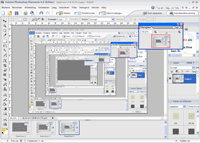Case comment on Softwarová
 Een bijdrage van Aimée van Hattum, Masterstudent IViR.
Een bijdrage van Aimée van Hattum, Masterstudent IViR.
On 22 December 2010, the Court of Justice of the European Union ('CJEU' or 'Court' – C-393/09) has answered two preliminary questions concerning copyright protection for the graphic user interface ('GUI') of a computer program under the Software Directive , as well as the InfoSoc Directive . Apart from the fact that this was the first decision in which the CJEU has interpreted the Software Directive, the BSA judgment is also worth being discussed because of its precedent-making character and its remarkably expressed considerations.
The reference to the CJEU resulted from a dispute between the Czech Business Software Alliance ('BSA') and the Czech Ministry of Culture ('the Ministry'). In 2001 BSA applied to the Ministry, seeking to obtain authorisation for the collective administration of copyright in computer programs, aiming to secure the right to the collective administration of GUIs. After the Ministry refused to grant the authorisation, litigation followed for nearly four years, after which the Ministry ultimately rejected BSA's application, inter alia , on the ground that copyright law protects only the object code and the source code of a computer program, but not the result of the display of the program on the computer screen, since the GUI is protected only against unfair competition.
After the Ministry dismissed BSA's appeal against such decision, BSA challenged the decision before the Czech courts . After another dismissal, BSA appealed on point of law arguing that a computer program is used when it is shown in a display on user screens and that, consequently, such use must be protected by copyright.
At this moment the Czech court decided to stay proceedings and refer two questions to the CJEU. First, whether the phrase 'the expression in any form of a computer program' of Article 1(2) of the Software Directive also includes the GUI of the computer program or part thereof, as a result of which the GUI would be protected by copyright as a computer program? Second, whether television broadcasting of a GUI, whereby the public is enabled to have sensory perception of the graphic user interface of a computer program or part thereof, albeit without the possibility of actively exercising control over that program, constitutes communication to the public of a work protected by copyright within the meaning of Article 3(1) of the InfoSoc Directive?
After briefly providing a background on the relevant area of law concerning copyright protection of computer programs , the author's analysis on the Court's reasoning will follow. The analysis will be divided into three general subtopics, which are consistent with the Court's examination of the questions: a) Copyright protection under the Software Directive, b) Harmonisation of the originality standard, and c) Communication to the public by television broadcasting.
Outline
1. History
2. Analysis
2.1. Copyright protection under the Software Directive
2.2. Harmonisation of the originality standard
2.3. Communication to the public by television broadcasting
3. Conclusion
Lees de gehele bijdrage inclusief uitgebreide verwijzingen, hier.





















































































